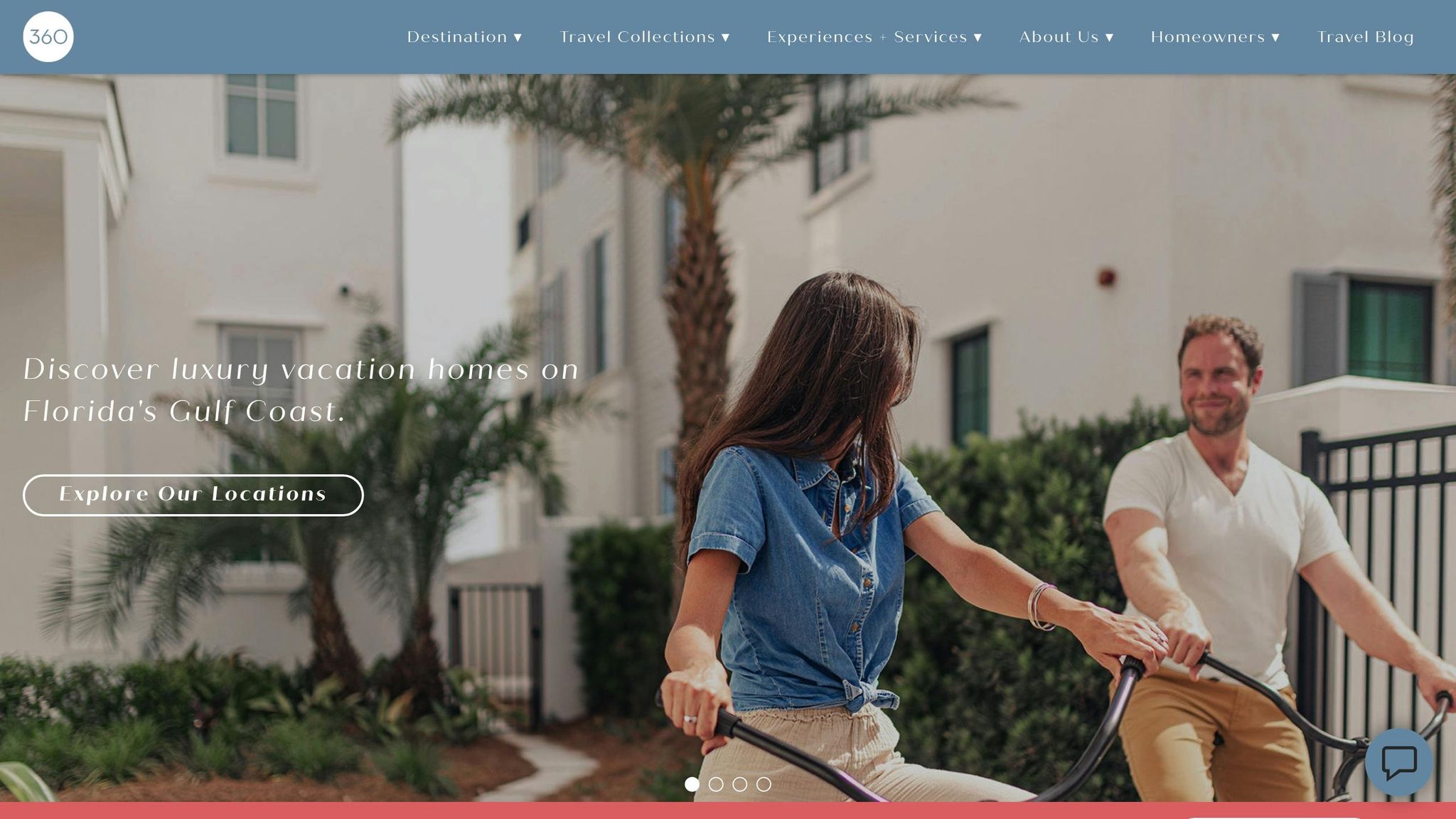The 30A luxury rental market in 2025 is thriving, driven by high-end properties, advanced amenities, and evolving guest preferences. Here's what you need to know:
- Revenue Growth: Ultra-luxury homes saw record-breaking sales, with $238 million in transactions this year. Properties valued over $10 million are in high demand.
- Rental Rates: Average daily rates (ADRs) range from $700 to $1,500+, with peak season occupancy at 80–90%.
- Top Communities: Rosemary Beach leads with ADRs up to $1,500 and annual revenues exceeding $350,000. Seaside and WaterColor follow closely.
- Guest Expectations: Travelers prioritize smart home tech, concierge services, and privacy. Longer stays and remote work are reshaping demand.
- Investment Challenges: Tightened regulations and higher interest rates require strategic planning, but returns of 6–8% remain achievable in established areas.
Key takeaway: Success in this market hinges on offering premium features, understanding guest needs, and navigating regulatory changes.
2025 Vacation Rental Market Trends in South Walton Florida with 360 Blue | 30A Florida Real Estate

Market Performance and Pricing Data
In 2025, the 30A luxury rental market has found its footing, showing steady performance with selective growth in certain property segments. The initial surge brought on by the pandemic has evened out, creating a more balanced market. However, luxury properties in prime locations continue to deliver strong results.
2025 Market Numbers
Luxury rentals along 30A command average daily rates (ADRs) ranging from $700 to over $1,500 per night, influenced by factors like location and amenities. Top-performing properties bring in impressive annual gross revenues of $200,000 to $350,000+, thanks to strategic pricing and the inclusion of modern features. During peak seasons, well-managed properties achieve occupancy rates of 80–90%, though off-peak months may see slight declines in some areas.
Seasonal Demand and Pricing
Summer remains the most profitable season for luxury rentals, with the highest rates achieved during these months. During the off-peak and shoulder seasons, ADRs typically drop by 20–40%, reflecting reduced demand. To adapt, many property owners now rely on real-time dynamic pricing that adjusts rates based on factors like local events, competition, and demand fluctuations. Some also enhance their slower seasons by offering personalized concierge services and exclusive amenities. Improved technology plays a crucial role, helping optimize pricing strategies throughout the year.
Market performance also varies significantly depending on the community, as outlined below.
Performance by Community
Each community along 30A offers a unique market dynamic. Established destinations dominate in pricing and revenue, while up-and-coming areas show potential for growth. The table below highlights the key performance metrics for major communities:
| Community | Peak ADR (USD) | Occupancy Rate (Peak) | Annual Gross Revenue (Est.) |
|---|---|---|---|
| Rosemary Beach | $1,200–$1,500 | 80–90% | $300,000–$350,000+ |
| Seaside | $1,000–$1,400 | 80–90% | $250,000–$320,000 |
| WaterColor | $1,000–$1,300 | 80–90% | $220,000–$300,000 |
| Other 30A Areas | $700–$1,200 | 70–85% | $150,000–$250,000 |
Rosemary Beach leads the pack, thanks to its strong reputation and limited property availability, which supports high pricing and revenue. Seaside continues to thrive with its distinctive charm and appeal, while WaterColor benefits from its wide range of amenities, including a well-regarded golf course. Emerging areas along 30A, though commanding lower rates for now, offer promising opportunities for investors looking to capitalize on growth potential.
Ultimately, the combination of location, top-tier amenities, and effective property management remains the key to success in the 30A luxury rental market.
What Drives Demand and Guest Needs
To understand the enduring appeal of 30A's luxury rental market, it's essential to look at the diverse range of visitors and their evolving expectations. These factors not only explain the market's consistent strength but also highlight the changing dynamics of guest preferences.
Who Visits 30A and Why
30A thrives as a drive-to destination, attracting visitors within a 6-8 hour drive radius. This accessibility ensures a steady flow of guests throughout the year, sustaining demand for luxury rentals.
Families remain a key demographic, drawn by the area's clean beaches and family-friendly amenities. Local guides like sowal.co spotlight the best attractions and dining options, making it an ideal getaway for all ages.
Another significant group is lifestyle buyers - individuals who invest in properties not just for financial returns but also for personal use and long-term value. These buyers often treat their properties as second homes, renting them out when not in use to generate additional income.
As the visitor base expands, so do their expectations for luxury and personalized experiences.
What Luxury Guests Want in 2025
Modern luxury travelers have raised the bar, looking for features and services that go beyond the basics:
- Smart home technology: Guests now expect AI-driven personalization for lighting, music, and temperature, along with smart locks and advanced climate control systems.
- Custom concierge services: Private chefs, curated local experiences, and tailored recommendations have become must-haves. Properties that utilize local insights, such as those from sowal.co, can deliver the exclusive experiences that high-end travelers crave.
- Sustainability: Energy-efficient appliances, eco-friendly materials, and green operational practices are increasingly important to environmentally conscious guests. Properties that blend luxury with sustainability appeal to this growing segment.
- Privacy and exclusivity: High-net-worth individuals prioritize private staff, exclusive membership perks, and enhanced security features. Some properties cater to this demand by joining exclusive rental networks offering VIP experiences.
- Social media influence: Instagrammable interiors, live virtual tours, and influencer endorsements now play a critical role in attracting bookings. Properties with strong visual appeal and unique experiences stand out to this audience.
Longer Stays and Remote Work Impact
The rise of remote work has reshaped the rental market by encouraging extended stays, even during traditionally slower periods. Remote workers often book midweek or during shoulder seasons, blending work and leisure in luxury rentals. This trend helps smooth out seasonal fluctuations and boosts overall occupancy rates.
To cater to these guests, properties must offer high-speed internet, dedicated workspaces, and quiet areas for video calls. Meeting these needs allows rentals to command higher rates, even during off-peak times.
The numbers tell the story: the average daily rate of $544.73 and annual revenues averaging $93,000 reflect the impact of longer stays and premium amenities. While the overall occupancy rate sits at 57%, properties that align with these trends continue to perform well. Flexible booking policies also play a role in maximizing occupancy and revenue potential.
sbb-itb-d06eda6
Investment Options and Market Risks
The 30A luxury rental market presents exciting opportunities for investors, but navigating it successfully means understanding both the potential for profits and the challenges posed by changing regulations and market conditions.
Profit Potential and Revenue Growth
Luxury vacation rentals along 30A continue to deliver impressive returns. Many prime properties yield annual returns between 6–8% after fees. For example, a luxury home in WaterColor with private beach access generated $180,000 in annual rental revenue at a 75% peak occupancy rate. Similarly, a spec home in Rosemary Beach, sold for $2.4 million, brought in $150,000 annually in rental income.
The ultra-luxury market is also setting new records. Properties priced above $10 million have seen transaction volumes climb to $238 million, with high-end sales more than doubling compared to the previous year. This trend reflects strong investor confidence and the enduring value of these properties. Even though single-family home prices have dipped slightly, rental income in well-established communities has remained steady.
New Rules and Permit Changes
Regulations in South Walton County are reshaping the investment landscape for 30A properties. Recent changes have tightened permitting requirements for short-term rentals, with stricter zoning rules and limits on the number of rental nights allowed per year.
These updates bring both challenges and opportunities. Properties with grandfathered permits or those in established neighborhoods tend to maintain higher values, while newer builds or homes in less regulated areas may face more hurdles. As demand grows for properties with existing, compliant rental licenses, these homes are commanding higher premiums. However, compliance costs are becoming a significant consideration. For investors, working with local experts who understand the permitting process is critical, as regulations vary widely by community. These evolving rules not only affect compliance expenses but also play a key role in how investors secure funding.
Financing Options and Market Conditions
With regulations tightening, financing strategies have become even more critical for investors. Higher interest rates in 2025 have made traditional mortgage financing more expensive, pushing many investors toward private lending, seller financing, or partnerships.
Cash buyers are increasingly dominating the market, particularly for properties in high-demand, amenity-rich neighborhoods. This trend has led to heightened competition, faster closings, and stronger negotiating power for buyers with liquid capital. Some investors are also tapping into equity from other properties or using bridge loans to acquire luxury rentals. While these alternative financing methods often come with higher costs, they provide much-needed flexibility in today’s tighter lending environment.
Another growing trend is partnership investments, where multiple investors pool resources to acquire high-value properties. This approach allows for diversification while sharing both risks and rewards. To navigate the complexities of financing luxury vacation rentals, working with lenders who specialize in this market is highly recommended. These experts can help investors manage the unique challenges of securing funding in the current climate.
Key Findings for 30A Luxury Rentals in 2025
The 30A luxury rental market in 2025 is poised for steady growth, fueled by rising ultra-luxury transactions and shifting guest expectations.
High-end property sales are leading the charge, with top-tier homes generating strong transaction volumes. This trend highlights a clear focus on quality and enduring value over short-term speculation. Despite an increase in available inventory, pricing remains stable, underscoring buyers’ preference for premium properties with long-term appeal.
Guests are now seeking rentals equipped with cutting-edge features like AI-powered smart home systems, biometric access, and bespoke concierge services. These amenities emphasize privacy and exclusivity, aligning with the rise of invitation-only booking networks that cater to elite travelers looking for unique, private experiences.
Summer continues to be the prime season for both rental income and property sales, with July standing out as the peak month for ultra-luxury transactions. This seasonal trend offers clear opportunities for investors aiming to optimize rental returns and plan strategic property sales.
To remain competitive, property owners need to embrace smart technology and distinctive designs. Properties that incorporate these elements consistently outperform others in terms of occupancy rates and revenue generation.
Investors should focus on established communities with strong amenities and proven performance. These areas are delivering annual returns of 6-8% while maintaining steady occupancy levels. However, investors must also navigate changing permitting requirements and financing hurdles to ensure sustainable returns.
For travelers booking luxury rentals, early reservations during peak seasons are key to securing the best properties. Prioritizing rentals with advanced amenities and exclusive perks can elevate the overall experience. Local resources like sowal.co can provide valuable insights into community events, hidden beaches, and the best times to visit, helping travelers make the most of their 30A stay.
Looking ahead, the market’s success will hinge on technology and personalization as key differentiators for top-performing properties. At the same time, staying compliant with regulations and adopting sound financing strategies will be essential for long-term investment success.
FAQs
What is driving the growing demand for luxury vacation rentals along 30A in 2025?
The allure of luxury vacation rentals along 30A in 2025 is being shaped by several key factors. A growing appetite for upscale travel experiences has positioned this picturesque stretch of Florida's Gulf Coast as a top choice for affluent travelers. With its stunning beaches, high-end amenities, and exclusive communities, 30A offers the perfect combination of relaxation and indulgence.
At the same time, a surge in vacation property investments is driving the availability of premium rentals. Property owners and investors are increasingly recognizing the area's potential for strong financial returns as demand continues to climb. What sets 30A apart is its ability to deliver unique experiences - whether it’s savoring gourmet cuisine, exploring boutique shops, or discovering secluded beaches. These features make it an irresistible destination for both visitors seeking luxury and investors looking for opportunities.
How are new regulations and changing interest rates affecting investment strategies in the 30A luxury rental market?
Regulatory shifts and changing interest rates are reshaping how investors engage with the 30A luxury rental market. Tighter zoning laws and new short-term rental restrictions in certain areas mean property owners must stay informed and ensure their investments comply with local regulations. At the same time, rising interest rates are pushing many investors to rethink their financing strategies. Some are turning to cash purchases, while others focus on properties with strong rental income potential to help balance the impact of higher borrowing costs.
For anyone eyeing investments along the 30A coastline, staying on top of these trends is essential for making smart decisions and thriving in this competitive, sought-after market.
What amenities and features will luxury guests expect in 2025, and how can property owners deliver on these expectations?
Luxury travelers in 2025 are expected to seek out personalized experiences, cutting-edge amenities, and environmentally responsible practices. To cater to these preferences, property owners should invest in modern smart home technology - think voice-activated controls and lightning-fast Wi-Fi - alongside luxurious essentials like private pools, spa-inspired bathrooms, and high-quality bedding.
For guests who value sustainability, features like energy-efficient appliances, eco-friendly building materials, and access to outdoor spaces will strike the right chord. Adding to the appeal, offering top-tier service, such as concierge support or thoughtfully curated local experiences, can create an unforgettable stay and encourage repeat visits.



